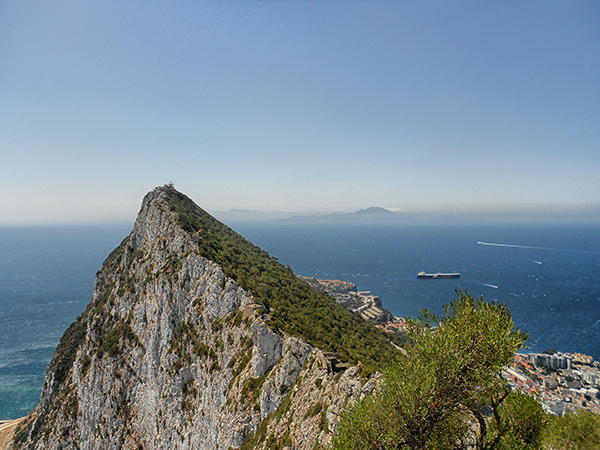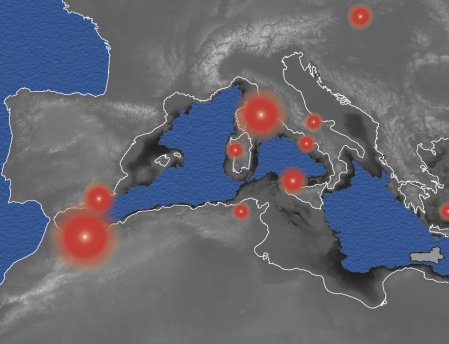
by Elizabeth Dengler Tuesday, January 16, 2018

The Strait of Gibraltar, the seaway connecting the Atlantic Ocean to the Mediterranean Sea between Africa and Europe, closed roughly 6 million years ago, initiating the Messinian Salinity Crisis. Credit: CC0
Between 5 million and 6 million years ago, during an event known as the Messinian Salinity Crisis (MSC), large amounts of seawater evaporated from the Mediterranean Sea leaving massive salt deposits in the basin. How much the sea surface dropped during the MSC is debated, but in a new study in Nature Geoscience, researchers suggest that a large, kilometer-scale drawdown of the Mediterranean Sea may explain not just the thick salt deposits but also a pulse of magmatic activity around the region that occurred at the same time as the MSC.
The MSC occurred when the Mediterranean Sea was cut off from the Atlantic Ocean by the closing of the Strait of Gibraltar— the narrow gap of sea that connects the two bodies — as a result of tectonic activity combined, possibly, with climatic changes that affected sea level. Once cut off from its major water source, the sea began evaporating and lowering, despite continued influxes to the basin from rivers and precipitation. While some scientists think a major drop of the Mediterranean Sea’s surface occurred during the MSC, others propose that the salt deposits (which range from a few meters to more than a kilometer thick in places), along with canyons carved into the Mediterranean seafloor at the time, could have formed in deep water, suggesting there was minimal drawdown of the sea surface. In the new study, Pietro Sternai, a research associate at the University of Geneva in Switzerland, and his colleagues found evidence in the volcanic record that indicates a larger drawdown.
Sternai’s team looked at the record of magmatism around the Mediterranean Basin at the time of the MSC, using the quantity and ages of igneous rock formations in the region as a proxy for magmatic activity. The group showed that there were roughly “twice as many volcanic eruptions during the MSC than on average during the [whole] Neogene [the period from 23 million to 2.6 million years ago],” Sternai says. While it’s possible that sampling bias and/or the loss of rock formations due to erosion since the MSC could have impacted the number of samples of a given age that were collected, he says, “from what we have today, the information seems to [suggest] that there was an increase in the number of volcanic eruptions during the MSC.”

The modern coastline of the Mediterranean Sea is shown in white in this diagram, while areas of the sea that would still be underwater after a 2-kilometer sea-level drop are shown in blue. Red circles denote the location and relative scale of enhanced magmatic activity during the Messinian. Credit: ©UNIGE
The team considered whether unloading from a large-scale desiccation of the Mediterranean Sea could significantly impact the rate of magmatism by means of decompression melting. Decompression melting occurs when a reduction in overlying pressure allows mantle rocks to melt at lower temperatures, thereby generating more magma. The evaporation of massive amounts of seawater would lighten the load on the crust similar to the way the melting of large glaciers or ice sheets relieves pressure on the land surface and allows for decompression melting and increases in magmatic activity.
Using a model that accounted for basin size and the thickness and temperature of the lithosphere beneath the Mediterranean Sea, the researchers found that a rapid, kilometer-scale drawdown of the sea could have increased melt production in the underlying mantle by 17 percent. Sternai notes that “it is relatively easy to transmit the stresses due to surface unloading down to the mantle.” In other words, it’s possible that a large drawdown of the Mediterranean Sea could have caused sufficient decompression melting in the mantle to account for the pulse in magmatism identified in the geologic record. Smaller-scale drawdowns, on the other hand, cannot “explain the magmatic pulse by the mechanisms proposed here,” he and his colleagues wrote.
In their model, the researchers “assume a reasonable lithosphere with reasonable properties, and a reasonable load geometry” of the Mediterranean Sea atop the lithosphere, says Jean-Arthur Olive, a geodynamicist now at the French National Center for Scientific Research in Paris. The researchers convincingly showed that, with these properties, some of the unloading effect from the evaporation of the sea would have been transmitted down to the mantle and subsequently back to the surface in the form of magmatic activity, Olive wrote in a commentary, also published in Nature Geoscience.
However, Olive points out that the magnitude of the unloading isn’t the only factor affecting decompression melting: Perhaps more important, he says, is how fast the unloading happens, as well as “the geometry of the load — where unloading happens relative to where the magma systems are.” Rather than definitively showing that large-scale unloading impacted volcanic activity around the basin at the time, Olive suggests that this study serves to “put the idea out there to trigger discussion, and show that it is a reasonable [question to ask].”
Sternai says his team’s findings have implications beyond illuminating the scale of the MSC. It affords “another opportunity to investigate the links between surface processes and magmatism,” he says. Volcanism is commonly thought of as impacting the climate by the injection of particulates and gases into the atmosphere, but this link also works the other way around. “As surface loads change, magmatism changes,” he says, noting that when large ice masses melt due to climatic warming, the unloading of the lithosphere could result in regional decompression melting and increases in volcanic activity.
Olive agrees that shallow and deep earth geodynamic processes can’t be separated entirely: “Things are inherently interconnected.” However, he cautions about drawing connections between surface unloading effects on volcanic activity and modern climate change because, he says, it would likely take thousands to tens of thousands of years to see the effects of unloading of melting ice sheets on volcanism.
© 2008-2021. All rights reserved. Any copying, redistribution or retransmission of any of the contents of this service without the expressed written permission of the American Geosciences Institute is expressly prohibited. Click here for all copyright requests.